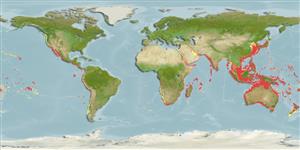Astropecten polyacanthus Müller & Troschel, 1842
Brown spotted combstar| Native range | All suitable habitat | Point map | Year 2050 |

|
| This map was computer-generated and has not yet been reviewed. |
| Astropecten polyacanthus AquaMaps Data sources: GBIF OBIS |
Classification / Names Common names | Synonyms | CoL | ITIS | WoRMS
Asteroidea | Paxillosida | Astropectinidae
Environment: milieu / climate zone / depth range / distribution range Ecology
Reef-associated; depth range 0 - 222 m (Ref. 106682). Tropical
Distribution Countries | FAO areas | Ecosystems | Occurrences | Introductions
Southeast Atlantic and entire tropical Indo-Pacific from Red Sea and South Africa to the Hawaiian Islands.
Length at first maturity / Size / Weight / Age
Maturity: Lm ? range ? - ? cm Max length : 12.0 cm WD male/unsexed; (Ref. 800)
Short description Morphology
Life cycle and mating behavior Maturity | Reproduction | Spawning | Eggs | Fecundity | Larvae
Main reference
References | Coordinator | Collaborators
Schoppe, S. 2000 A guide to common shallow water sea stars, brittle stars, sea urchins, sea cucumbers and feather stars (echinoderms) of the Philippines. Times Media Private Limited, Singapore. 144 p. (Ref. 800)
IUCN Red List Status
(Ref. 130435: Version 2025-1)
CITES status (Ref. 108899)
CMS (Ref. 116361)
Threat to humans
Human uses
| FishSource |
Tools
More information
Max. ages / sizes
Length-weight rel.
Length-length rel.
Length-frequencies
Mass conversion
Abundance
Internet sources
BHL | BOLD Systems | CISTI | DiscoverLife | FAO(Publication : search) | Fishipedia | GenBank (genome, nucleotide) | GloBI | Gomexsi | Google Books | Google Scholar | Google | PubMed | Tree of Life | Wikipedia (Go, Search) | Zoological Record



